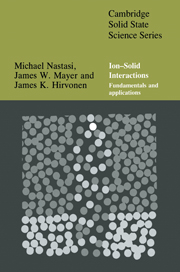Book contents
- Frontmatter
- Contents
- List of symbols
- Preface
- Chapter 1 General features and fundamental concepts
- Chapter 2 Interatomic potentials
- Chapter 3 Dynamics of binary elastic collisions
- Chapter 4 Cross-section
- Chapter 5 Ion stopping
- Chapter 6 Ion range and range distribution
- Chapter 7 Radiation damage and spikes
- Chapter 8 Ion–solid simulations and diffusion
- Chapter 9 Sputtering
- Chapter 10 Order–disorder and ion implantation metallurgy
- Chapter 11 Ion beam mixing
- Chapter 12 Phase transformations
- Chapter 13 Ion beam assisted deposition
- Chapter 14 Applications of ion beam processing techniques
- Chapter 15 Ion beam system features
- Appendix A Crystallography
- Appendix B Table of the elements
- Appendix C Density of states
- Appendix D Derivation of the Thomas–Fermi differential equation
- Appendix E Center-of-mass and laboratory scattering angles
- Appendix F Miedema's semi-empirical model for the enthalpy of formation in the liquid and solid states
- Appendix G Implantation metallurgy – study of equilibrium alloys
- Appendix H Physical constants, conversions and useful combinations
- Index
Chapter 9 - Sputtering
Published online by Cambridge University Press: 27 January 2010
- Frontmatter
- Contents
- List of symbols
- Preface
- Chapter 1 General features and fundamental concepts
- Chapter 2 Interatomic potentials
- Chapter 3 Dynamics of binary elastic collisions
- Chapter 4 Cross-section
- Chapter 5 Ion stopping
- Chapter 6 Ion range and range distribution
- Chapter 7 Radiation damage and spikes
- Chapter 8 Ion–solid simulations and diffusion
- Chapter 9 Sputtering
- Chapter 10 Order–disorder and ion implantation metallurgy
- Chapter 11 Ion beam mixing
- Chapter 12 Phase transformations
- Chapter 13 Ion beam assisted deposition
- Chapter 14 Applications of ion beam processing techniques
- Chapter 15 Ion beam system features
- Appendix A Crystallography
- Appendix B Table of the elements
- Appendix C Density of states
- Appendix D Derivation of the Thomas–Fermi differential equation
- Appendix E Center-of-mass and laboratory scattering angles
- Appendix F Miedema's semi-empirical model for the enthalpy of formation in the liquid and solid states
- Appendix G Implantation metallurgy – study of equilibrium alloys
- Appendix H Physical constants, conversions and useful combinations
- Index
Summary
Introduction
Ion implantation is a process by which virtually any element can be injected into the near-surface region of any solid by causing a beam of high-velocity ions, usually 10 to 400 keV in energy, to strike a target mounted in a vacuum chamber. The resulting depth concentration profile of implanted dopant atoms can be calculated using the theoretical considerations discussed in Chapter 6. At low ion doses, ø (i.e., the number of ions per unit area), the depth concentration profiles are well characterized by a Gaussian distribution centered about an average projected range, Rp. At high fluences, ≥ 1017/cm2, where the concentration of implanted atoms approaches tens of atomic per cent, other effects, such as sputtering and ion beam induced migration of atoms, can significantly alter or limit the ultimate concentrations attainable.
This chapter deals with the erosion of the sample by energetic particle bombardment. In this process, called sputtering, surface atoms are removed by collisions between the incoming particles and the atoms in the near-surface layers of a solid. Sputtering sets the limit of the maximum concentration of atoms that can be implanted and retained in a target material. The yield of sputtered atoms, the number of sputtered atoms per incident ion, typically lies in the range 0.5–20 depending upon ion species, ion energy, and target material. For direct ion implantation into a target material, the maximum concentration of implanted species is inversely proportional to the sputter yield.
- Type
- Chapter
- Information
- Ion-Solid InteractionsFundamentals and Applications, pp. 218 - 253Publisher: Cambridge University PressPrint publication year: 1996
- 2
- Cited by



